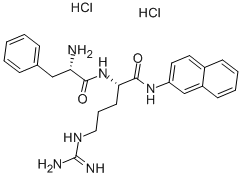100929-99-5
 100929-99-5 結(jié)構(gòu)式
100929-99-5 結(jié)構(gòu)式
基本信息
苯丙氨酸-精氨酸-Β-萘胺
苯丙氨酸-精氨酸 Β-萘胺 二鹽酸鹽
化合物PAΒN DIHYDROCHLORIDE
L-苯丙氨酰-N-2-萘基-L-精氨酰胺二鹽酸鹽
苯丙氨酸-精氨酸-氨基甲酸丁酯鹽酸鹽(英文名為準(zhǔn))
H-Phe-Arg-bNA·2HCl
110 dihydrochloride
PAβN dihydrochloride
H-Phe-Arg-βNA · 2 HCl
H-PHE-ARG-BETANA 2 HCL
PAβN (dihydrochloride)
Phe-Arg β-naphthylamide
MC207110 dihydrochloride
MC-207110 dihydrochloride
物理化學(xué)性質(zhì)
常見問題列表
PAβN increases the susceptibilities of the three pump-overexpressing mutants of P. aeruginosa to levofloxacin 64-fold. PAβN also potentiates the activity of levofloxacin against strain PAM2391 containing plasmid pAGH97 with the mexXY genes and against wild-type strain PAM1020. PAβN has an effect on susceptibilities to other antibiotics that are substrates of efflux pumps. PAβN increases levels of accumulation of efflux pump substrates inside the cell. It enhances the activity of levofloxacin against clinical isolates of P. aeruginosa . PAβN reduces the MICs in nine ciprofloxacin-resistant isolates, and in four of these, PAβN increases the susceptibility by twofold. Moreover, PAβN restores ciprofloxacin susceptibility in five of the ciprofloxacin-resistant isolates. In addition, clear effects of NMP on the ciprofloxacin MICs are seen for 20 of these ciprofloxacin-resistant isolates. PAβN permeabilizes bacterial membranes in a concentration-dependent manner at levels below those typically used in combination studies, and this additional mode of action should be considered when using PAβN as a control for efflux studies.
